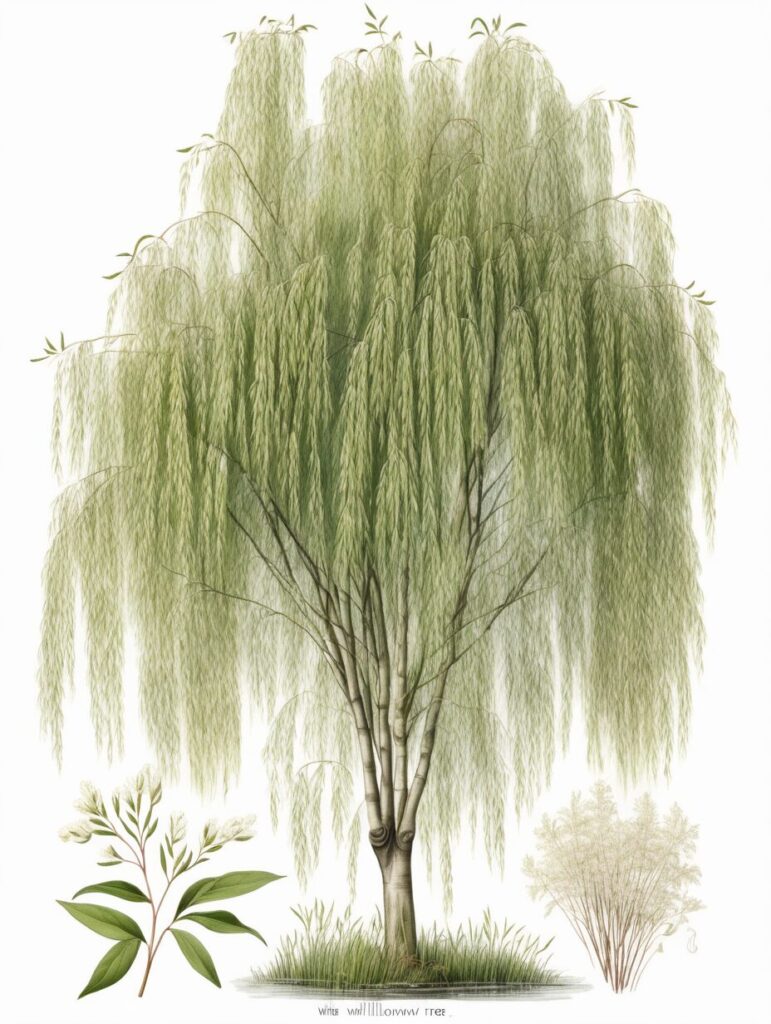White Willow, with its graceful branches and profound connection to nature, serves as a timeless symbol of resilience and adaptability. This remarkable tree, with its roots firmly anchored in the soil, embodies the strength that comes from staying grounded in our values and relationships. The willow, often found near water bodies, is a living testament to the importance of being adaptable and flexible, qualities that are essential in navigating life’s challenges. The remarkable ability of willows to bend without breaking, even in fierce storms, teaches us the value of flexibility in times of adversity, encouraging us to emulate the willow’s elegance and grace under pressure.



The significance of willows in our ecosystems extends beyond mere beauty; they provide shelter and habitat for countless creatures, demonstrating the importance of community and interconnectedness. Their gently swaying branches create a sanctuary for birds, insects, and small mammals. This role as a provider of refuge highlights the social nature of willows, offering lessons in cooperation and support within our communities. The willow’s deep root systems, which prevent soil erosion and promote environmental restoration, remind us of our responsibility to care for our surroundings, advocating for conscious environmental stewardship.
The healing properties of willow bark have been revered for centuries, underscoring the potential of natural solutions to address human ailments. The bark, known for its content of salicin, serves as the foundation for aspirin, illustrating the deep-rooted wisdom found in nature’s pharmacy. Salicin, a potent compound with pain-relieving and anti-inflammatory properties, has been historically employed to ease headaches, reduce fever, and alleviate the discomfort of arthritis and muscle pain. This age-old remedy serves as a testament to the willow’s healing prowess and its role as a natural ally in promoting wellness and relief.
The discovery of the medicinal properties of willow bark is an intriguing narrative involving various cultures and figures from history. Ancient Greeks and Egyptians, followed by notable figures like the Swiss physician Paracelsus, French chemists Henri and Pierre-Joseph Leroux, and German chemist Raffaele Piria, were instrumental in isolating and synthesizing salicin, which eventually led to the development of aspirin by Felix Hoffmann. Despite aspirin being synthesized, the natural attributes of willow bark provide a gentler alternative with fewer gastrointestinal side effects due to its slower absorption rate and rich antioxidant profile.
Antioxidants in willow bark, particularly flavonoids, play a vital role in safeguarding our cells from oxidative damage caused by free radicals, contributing to overall health and well-being. These compounds enhance the immune system, reduce inflammation, and offer protection against chronic diseases, such as cancer and cardiovascular ailments. Moreover, the bark’s fibrous constitution has been utilized historically in creating durable ropes, intricate baskets, and even musical instruments, emphasizing that the willow is not just a healer but a versatile provider of essential resources.
Throughout history, the willow tree has also been embedded within the cultural fabric of societies worldwide, symbolizing intuition, dreams, and inspiration. In various legends and traditions, willows represent themes of transformation, mourning, and rebirth. The Greeks associated willows with the goddess Hecate, while Celtic traditions revered the tree as a guardian of the dead and a symbol of the cyclical nature of life and death. These cultural associations highlight the willow’s role in inspiring introspection and providing wisdom from the natural world.
William Wordsworth’s poignant verses capture the willow’s essence, illustrating its connection with grief and reflection. His poem “The Weeping Willow” beautifully articulates the profound sense of longing and melancholy often linked with this tree, yet it is within this sorrow that the willow reflects resilience and grace. The cyclical shedding of leaves and seasonal transformations serve as a reminder of life’s ever-turning wheel, urging us to embrace change and renewal with a light heart.
From the perspective of traditional medicine and holistic wellness, willow aligns with Ayurvedic principles by balancing Vata dosha. Its calming and grounding properties stabilize Vata’s energies, promoting a peaceful state of mind while easing pain and inflammation. The synergy of these elements makes willow bark an appealing remedy for those seeking equilibrium within themselves.
The willow’s adaptability extends to its planting and propagation. Its propensity to thrive near water is matched by its simple reproduction through cuttings, a testament to its natural resilience and determination to grow in diverse environments. To cultivate willow trees in gardens, gardeners can employ either softwood or hardwood cuttings, ensuring the cuttings are provided with adequate moisture and temperature until root development is achieved.
It is essential to plant willow trees with consideration to their environment, particularly avoiding areas too close to wells or septic systems to prevent root interference. Once established, willows flourish rapidly, often reaching impressive heights with minimal care, making them both a graceful addition to landscapes and a functional ally in protecting the environment.
When harvesting willow bark, optimal timing is crucial. Early spring, just before buds swell, marks the prime moment to extract the bark richest in salicin. Utilizing a sharp knife, the bark is carefully removed from the branches without damage to ensure the tree’s continued health. Once harvested, the bark and its supplementary parts, such as leaves and twigs, require gentle drying in ventilated areas away from direct sunlight, preserving their medicinal qualities for future use.
Beyond traditional remedies, modern interest has piqued in willow bark’s potential benefits for the human microbiome. Research indicates that salicin and other compounds in willow bark influence gut health by encouraging beneficial bacteria such as Lactobacilli and Bifidobacteria. Concurrently, it shows promise in suppressing harmful bacteria, like E. coli, while offering a protective effect against H. pylori, reinforcing the integrity of gut barriers and reducing the risk of gastrointestinal issues.
The exploration of willow bark’s impact on the microbiome reveals a fascinating intersection of herbal medicine and modern science, indicating potential roles beyond pain relief, such as promoting gut health and balancing the body’s natural flora. Although further studies are necessary to fully understand these implications, the preliminary findings point toward enduring benefits tied to the use of this ancient remedy.
Willow bark’s versatile applications underscore its enduring value. Its preparation into teas, tinctures, and compresses tailors its benefits to specific needs, from soothing headaches with gentle teas to addressing localized discomfort with targeted compresses. For those wielding holistic blends, it pairs well with ylang-ylang essential oil in toners aimed at skin health, or as part of healing honeys blended with turmeric and ginger.
Willow’s storied history, diverse applications, and inherent wisdom create a tapestry woven through both ecological and cultural significance. As a companion and healer, the willow tree endows us with the reminder that strength lies in adaptability, community holds power in interconnectedness, and true wellness—both physical and spiritual—can be found by tapping into nature’s profound insights. The willow remains whispering beside waters, a presence of peace for dreamers, seekers, and those longing for solace amid the complexity of life.
White Willow Bark Honey
Ingredients
4 tbsps fresh ginger, finnely grated
4 tbsps white willow powder
4 tbsps turmeric powder
4 tbsps apple cider vinegar
1 cup raw honey
Combine all the ingredients together in a small jar, mix well, and seal. Infuse for 1 week.
Dosage: Use 2 tsps per day to prevent pain or when your muscles are feeling achy.
Storage: Keep in a sealed jar in the fridge for several weeks.
Add the bark to a tea flter (paper or metal) Place it in a cup Pour over boiling water Let it sit for 10-15 minutes Combine the rest of the ingredients in a 30 ml glass bottle (witch hazel, glycerin, and essential oils), shake the bottle well to combine Fill the rest of the bottle with willow bark “tea”
Rooting Hormone from Willow
Trim the younger growing tips of willow trees that are no more than a pencil width thick. The bark should be fresh and colored, from last year’s growth. You’ll have some greyed bark, too, and that’s alright. Under the greyed bark there is more of what you need.
Thicker woody pieces are too difficult to cut for this project though.
Remove the leaves from the stems.
Cut the branches into one-to-two-inch pieces. You don’t need to be exact. The more surface area that is exposed the easier the plant constituents will dissolve into the water.
Place the willow pieces into a heat proof container. Fill the container half full of willow pieces.
Put the jar in a warm spot to preheat a bit before moving on to the next step. Boil some water. Take the water of the heat and let it cool down slightly, if you are using a heat proof glass jar. Pour water over the willow pieces in the container. Fill the container all the way up with boiling water. Cover the container to hold in heat. Let the willow steep for 48 hours. Strain out the willow pieces.
Retain the willow water; this is your homemade rooting hormone. How to use willow rooting hormone with softwood cuttings The best time to take softwood cuttings from ornamental shrubs and perennials is May or June, when the softwood cutting is no longer flexible but before the hardwood has begun to form. To root these, pour some water in a small vase or Mason jar.
Soak the cuttings in the cooled willow water for 24 hours. Plant the cuttings in soil-less medium, in a pot. Cover loosely with a cloche or plastic bag to prevent moisture loss by evaporation. Softwood cuttings should be rooted in 6 to 8 weeks. To test the rooting progress, give the cuttings a small tug. If the plant resists, it is rooted.
When you use your willow water, pour out just what you need into another container. To protect the integrity of your homemade rooting hormone, don’t pour the used solution back into the original jar. Use it to water plants, instead.
The willow water will keep for two months in the refrigerator. Use this homemade rooting hormone to water your garden and then make more. But this is only a rule of thumb. It may in fact last longer.




